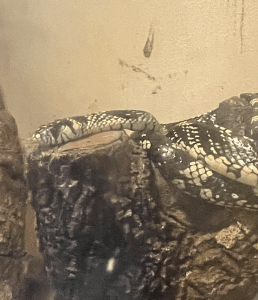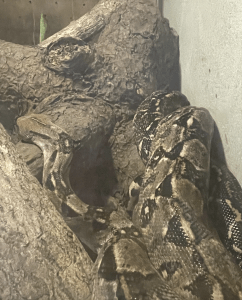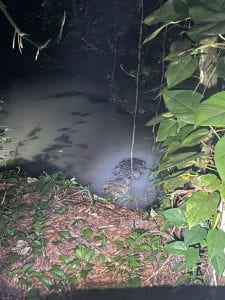We spent the morning going over the results of our cecropia tree experiments and making a poster to present those results to the instructors. The results were mixed—while some of the leaves did appear eaten, others actually seemed to have gained mass. We chalked this up to the leaves rehydrating in the containers, as there was also water inside for the herbivorous insects. It also seemed like the leaves from the young, uncolonized tree lost more mass, although difference was slight. This surprised me—I had assumed that, without ants to defend them, the young cecropia trees had developed some other defense mechanism. There were lots of factors we weren’t able to control for which added confounding variable, such as the species of herbivore and the age of the cecropia tree. It would also probably be better to sample more trees. We came up with a theoretical laboratory follow-up in which we grew cecropia trees and prevented one from being colonized, giving us more control over the conditions.


We also were treated with a presentation from Rafael Manzanero, the director of FCD (Friends for Conservation and Development), the organization that manages oversees Las Cuevas. He told us about the different types of work FCD does, from resource management to research to protection. He also told us about some of the challenges FCD faces, particularly since Covid.
After lunch, we had student lectures and a presentation from Yasmini Manzanero, who does cultural heritage work with FCD. She went into more detail about the history of the caves as well as the cultural and natural wonders which can be found inside. FCD works together with the Belizean Institute of Archeology to document and manage the caves, and we learned about how that relationship works as well. It really showcased another side of the work being done in this place—the work of the karst team is so fascinating,
Later the afternoon, we set out to investigate leafcutter ant fungal gardens. Basically, leafcutter ants will bring leaves back to their colony feed a fungus which they then eat. Mature colonies can have tens or hundreds of fungal garden chambers. We first went to a young leafcutter and colony, probably just over one year old, and excavated the fungal garden. We hit it pretty quickly, and we were able to pull it out intact. It had the queen right on it, along with many workers. It was too young to have any soldiers, though. After inspecting it, we moved on to a mature colony. The immature colony was in the clearing with the research station, but to find an ideal mature colony we ventured down the road a bit. We wanted one that was raised so we wouldn’t have to dig deep to find the fungal garden. The mature colony was well-defended and after only a few strokes with the shovel the soldier ants came pouring out. We had to keep stomping our boots to shake them off. Eventually, though, we uncovered the fungal garden and pulled out a sample of the fungus. It was really interesting to see nests of such radically different sizes.


We ended the day with a night hike. We did the Maya trail which goes in a loop, and we walked slow so we could see as much wildlife as possible It had been so dry that we were limited in what we were able to see, but there was still a huge diversity of insects that were super active. We also got to see two anoles and. One interesting thing we came across was some fake snakes (made of clay) being used for research purposes. By far the best part, in my opinion, was when we all turned our headlamps off and and stayed quiet for a minute to listen to the forest. It was so peaceful and the stars were beautiful! What a way to end our day.










